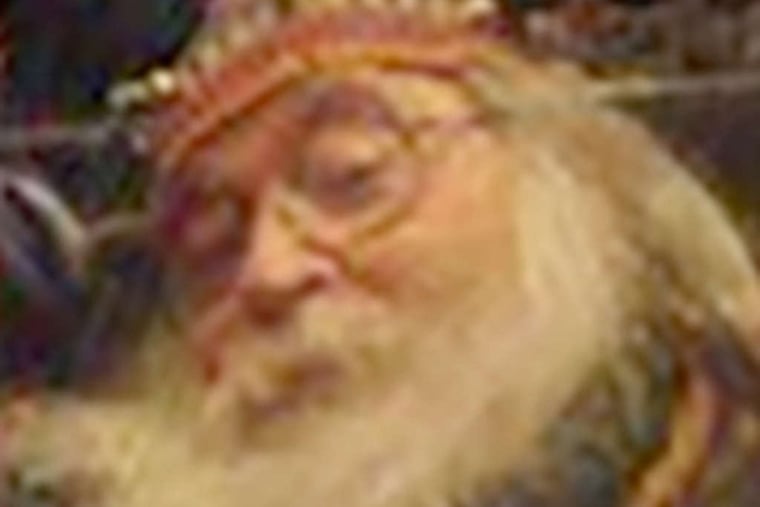Phillips Simkin, artist of sardonic wit
Phillips Simkin, 69, a Philadelphia artist who created installations using his humor and off-the-wall artistic vision, died Tuesday, Nov. 26, of congestive heart failure at his home.

Phillips Simkin, 69, a Philadelphia artist who created installations using his humor and off-the-wall artistic vision, died Tuesday, Nov. 26, of congestive heart failure at his home.
In his artist's statement, Mr. Simkin wrote that he regarded his art activities as pseudo-enterprises "often laced with a dose of sardonic wit and humor, parody and puns."
He hewed to that vision.
He was most renowned for casting and copyrighting the crack in the Liberty Bell at Independence National Historical Park, which he did after receiving permission from the National Park Service.
Mr. Simkin cast the crack in plaster, patina - so that it would resemble bronze - and chocolate. He told viewers that he saw the work as turning a negative into a positive.
A solo exhibition with installations and prints made from the casting was featured at the University of Pennsylvania's Institute of Contemporary Art.
His work also was exhibited at the Marian Locks Art Gallery and the Pennsylvania Academy of the Fine Arts.
In 1967, he began producing conceptual art projects and environmental performance installations. At the Institute of Contemporary Art, he presented Your Fifteen Minutes for a show titled "Made in Philadelphia." Thousands of visitors performed and watched others perform under a marquee on a stage he constructed.
For Art Park, a national invitational art exhibition near Niagara Falls, he built an entire town called Philston - as in Phil's town - made up of buildings formed to spell the letters in that name.
"He was quite a character," said John Formicola, a fellow artist and longtime friend. "For that one, he decided he would build his own town."
Mr. Simkin was commissioned to construct a performance piece in 1980 for the XIII Winter Olympics in Lake Placid, N.Y., and created a village out of illuminated ripstop nylon entitled Rosebud 2.
Other projects included the 1984 Cable Knitted News - a play on cable-TV news - part of the Capp Street Project in San Francisco. Mr. Simkin knitted and wove news and features into textiles he made on industrial looms.
In the early 1970s, he created Displacement Project 2 for the Philadelphia Museum of Art. The work entailed assembling the images of 20,000 pinhole cameras. Museum-goers used the cameras to take pictures, which became part of an art book. The pinhole camera project was repeated in 1974 at the Institute of Contemporary Art in Boston.
For LOVE Park in Center City, Mr. Simkin made a 76-piece puzzle that could be fitted into a 40-foot square. Passersby were asked to wear the human-sized pieces and move around the park until they found the matching puzzle parts.
"He loved the interaction of the people with the artwork," Formicola said.
In 1984, he constructed IFACTS, which stood for "institute for advanced creative thoughts and stuff," for the University City Science Center at Penn. Mr. Simkin refurbished a 1950s diner and installed it at 36th and Market Streets.
In 1986, he established DARING, an ersatz real estate venture with a real estate office and "conceptual" sales of property and goods. The exhibition was sponsored by Temple University's Tyler School of Art with a grant from the National Endowment for the Arts.
Other installations included a three-dimensional puzzle train for the St. Louis, Missouri Light Rail Bi-State MetroLink titled Metro Louie & the Links.
In another installation, commuters were asked to whisper secrets into phones at 30th Street Station. In return, they would hear the anonymous secrets of others. The work, sponsored by the train station, was titled Public Center for the Collection and Dissemination of Secrets.
"He always did projects on a grand scale, and he never failed to entertain," Formicola said.
In 1995, Mr. Simkin was awarded a competitive commission to create an installation for the Criminal Justice Center in Center City. He constructed a two-story sculpture called the Philadelphia Books of Just Hours.
Born in Philadelphia, Mr. Simkin attended Central High School and Tyler School of Art.
He received a master of fine arts degree and a fellowship in printmaking from Cornell University and served as a postgraduate fellow in the University of Pennsylvania's Department of Fine Arts.
He was an assistant professor of art at the University of Maryland and taught design at Moore College of Art in Philadelphia. He also taught courses at Swarthmore College and Drexel University.
In 1973, he joined the City University of New York (CUNY) Senior College in Jamaica, N.Y., as a full professor, teaching two- and three-dimensional design, computer graphics, and printmaking. Weary of the commute, he retired in 2010 as professor emeritus.
Mr. Simkin received the National Endowment for the Arts Individual Artist Fellowship, the Louis Comfort Tiffany Prize Award, and other national grants and awards.
In retirement, he shifted to computer-based images that he said addressed "abstract issues of memory, possession, and ingenuity." He did computerized digital printmaking and developed iPad applications, including a series of 123 images that appear on his domain, i-fingerlys.com.
Surviving are his wife, the former Lois Johnson, a printmaker who has Alzheimer's disease, and a sister.
A funeral was held Thursday, Dec. 5.
Contributions may be sent to the Alzheimer's Association Delaware Valley Chapter, 399 Market St., Suite 102, Philadelphia 19106.
610-313-8102